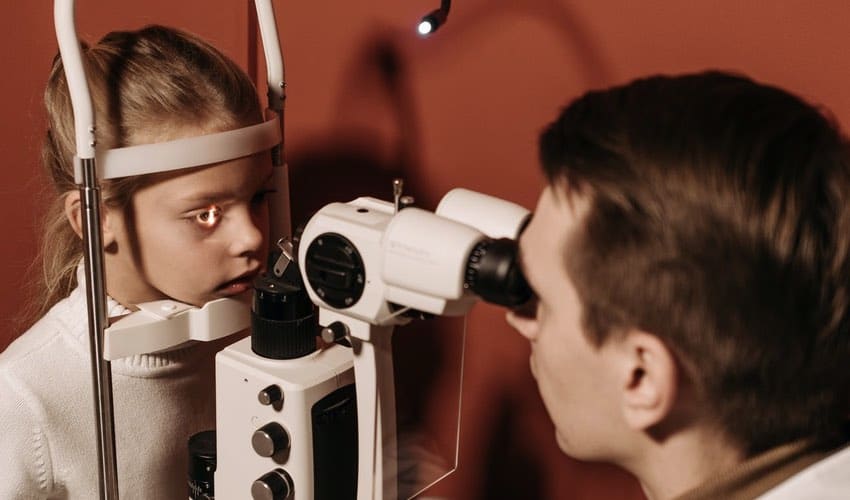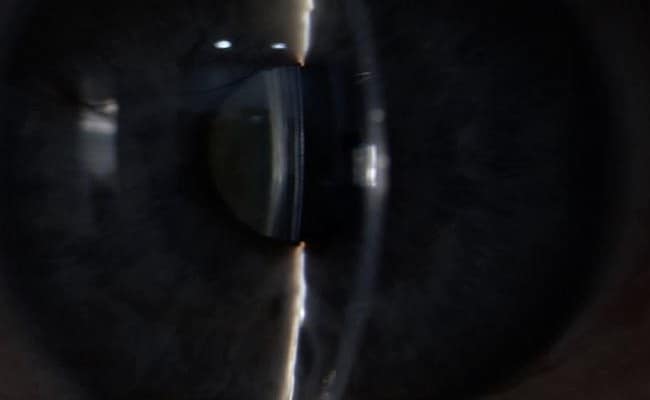There are multiple checkups an optician or optometrist can perform when he or she shines a light in your eye. One of them to measure your prescription objectively by evaluating the movement of the light reflected by your retina back through your pupil. Another important factor to check would be if your cornea shows any abnormalities.
In this article, you will see in detail why the optician shines a light in your eye and what he can see with this information. First of all, I am a master optician and I am a fan of explaining what I do to my customers. This way they are always up to date on what I am about to check during the measurements.
Shining a Light in and on Your Eye and through the Cornea
There are different techniques used by opticians to check for abnormalities on your eye and to see if it might be a good idea to refer to an eye doctor because of the check-up performed. During those check-ups, different light shines in your eye. It can be a tiny beam a diffuse type of light or even different colors like blue.
With all the different techniques the optician watches the transparency, reflections, and if shadow-like effects might be present. This way he or she can tell if the light travels unhindered into the eye or if something blocks the light from reaching your retina.

In some cases, a special dye is used in combination with blue light to make tiny injuries visible that would otherwise be missed under normal observation. This is also why the optician will pay close attention to the white areas of your eyes and the lids. A clogged gland for example to cause wetting issues and gives professional information if the measurements hereinafter make sense or if it would be wiser to reschedule the measurements.
Shining a Light in Your Eye To Check the Transparency of the Different Parts of the Eye
The tools opticians use are extremely versatile. One of those tools is the slit lamp which is essentially a microscope with a lamp attached to it that shines in your eye. When this device is used the optician can see how the light beams travel through your eyes. In some cases when the customer is older what the optician can see is cloudiness in the different parts of the eye.
The most common one is caused by a cataract. The lenses turn a little yellow and the light does not travel as perfectly through the lens as it would without the cloudiness. This way the optician can tell with the information he is gathering during the eye tests if new glasses right now would be a good idea or you might speak to an optical doctor first to talk about surgery first. Because when the lens gets changed to get rid of the cloudiness your prescription will be different after you received new lenses.

With the slit lamp, the optician is also to be able to see if some particles lost contact with the iris and are now floating around. The optician typically has a standardized sequence and settings for the instruments that shine a light in your eye and when the preliminary talk brings up a topic the sequences get individualized for you so the optician can perform a more detailed checkup of what the talk brought up.
Some opticians also have a closer look on the back of your eye to see if any abnormalities show up there which could influence your visual acuity. Depending on the country you live in this might only be done by optical doctors. Opticians are technicians educated to manufacture the best possible eyewear for you but they are not optical doctors.
Shining a Light and Looking at the Movement of the Reflections in Your Eye
When the light shines in your eye and the optician causes the light to permanently move a little he is using a sciascope. With this device and lenses hold in front of your eye he is able to find the prescription without talking to you.
What the optician can see with this device is flickering when the right lens power is found in front of your eye to correct your vision. In addition, the orientation of astigmatism also can be measured. Today it is oftentimes used for a first measurement and afterward the fine-tuning happens when you get asked what you see.
This device is really common to be used when the person can not give answers like little children. Although those measurements only take up a couple of minutes the optician can receive extremely detailed information about the prescription needed. When the customer can not fixate the eyes on a certain object and hold still for a moment even in those short moments an experienced optician is able to perform the measurements.
In some cases, this might look like the measurements only took a blink of an eye and the optician has the prescription and can move on with other examinations. When the customer can not hold still enough of course those measurements have their limitations as every measurement has. When this measurement is performed in some cases the pupils get dilated to see the reflections better. Depending on your country this might only be done by optical doctors exclusively.
Conclusion
As you can see there are many different reasons why the optician shines a light in or at your eye. I am sure the optician will happily provide you more information if you as a customer have any questions left. As an optician myself I can tell out of the experience double-checking the eyes of my customers proved to be very viable for them and for me. This way I can give the customer information and prepare them more efficiently for the performance of their glasses when an abnormality shows up during the examination.
Discussing things that might hinder visual acuity or referring the customer to an optical doctor makes a far better impression than doing this after the glasses are made.
I wish you a great day.
